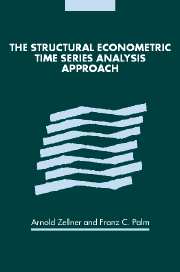Book contents
- Frontmatter
- Contents
- List of contributors
- Acknowledgments
- Introduction
- Part I The SEMTSA approach
- Part II Selected applications
- Part III Macroeconomic forecasting and modeling
- 13 Macroeconomic forecasting using pooled international data (1987)
- 14 Forecasting international growth rates using Bayesian shrinkage and other procedures (1989)
- 15 Turning points in economic time series, loss structures, and Bayesian forecasting (1990)
- 16 Forecasting turning points in international output growth rates using Bayesian exponentially weighted autoregression, time-varying parameter, and pooling techniques (1991)
- 17 Bayesian and non-Bayesian methods for combining models and forecasts with applications to forecasting international growth rates (1993)
- 18 Pooling in dynamic panel data models: an application to forecasting GDP growth rates (2000)
- 19 Forecasting turning points in countries' output growth rates: a response to Milton Friedman (1999)
- Part IV Disaggregation, forecasting, and modeling
- Subject index
- Author index
- References
18 - Pooling in dynamic panel data models: an application to forecasting GDP growth rates (2000)
Published online by Cambridge University Press: 24 October 2009
- Frontmatter
- Contents
- List of contributors
- Acknowledgments
- Introduction
- Part I The SEMTSA approach
- Part II Selected applications
- Part III Macroeconomic forecasting and modeling
- 13 Macroeconomic forecasting using pooled international data (1987)
- 14 Forecasting international growth rates using Bayesian shrinkage and other procedures (1989)
- 15 Turning points in economic time series, loss structures, and Bayesian forecasting (1990)
- 16 Forecasting turning points in international output growth rates using Bayesian exponentially weighted autoregression, time-varying parameter, and pooling techniques (1991)
- 17 Bayesian and non-Bayesian methods for combining models and forecasts with applications to forecasting international growth rates (1993)
- 18 Pooling in dynamic panel data models: an application to forecasting GDP growth rates (2000)
- 19 Forecasting turning points in countries' output growth rates: a response to Milton Friedman (1999)
- Part IV Disaggregation, forecasting, and modeling
- Subject index
- Author index
- References
Summary
In this chapter, we analyze issues of pooling models for a given set of N individual units observed over T periods of time. When the parameters of the models are different but exhibit some similarity, pooling may lead to a reduction of the mean squared error of the estimates and forecasts. We investigate theoretically and through simulations the conditions that lead to improved performance of forecasts based on pooled estimates. We show that the superiority of pooled forecasts in small samples can deteriorate as the sample size grows. Empirical results for postwar international real gross domestic product growth rates of 18 Organization for Economic Cooperation and Development countries using a model put forward by Garcia-Ferrer, Highfield, Palm, and Zellner and Hong, among others illustrate these findings. When allowing for contemporaneous residual correlation across countries, pooling restrictions and criteria have to be rejected when formally tested, but generalized least squares (GLS)-based pooled forecasts are found to outperform GLS-based individual and ordinary least squares-based pooled and individual forecasts.
Panel data are used more and more frequently in business and economic studies. Sometimes a given number of entities is observed over a longer period of time, whereas traditionally panel data are available for a large and variable number of entities observed for a fixed number of time periods (e.g. see Baltagi 1995 for a[n] … overview; Maddala 1991; Maddala, Trost, and Li 1994).
- Type
- Chapter
- Information
- The Structural Econometric Time Series Analysis Approach , pp. 590 - 611Publisher: Cambridge University PressPrint publication year: 2004
References
- 1
- Cited by

